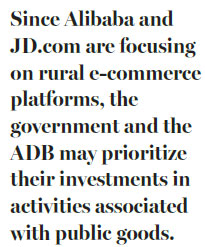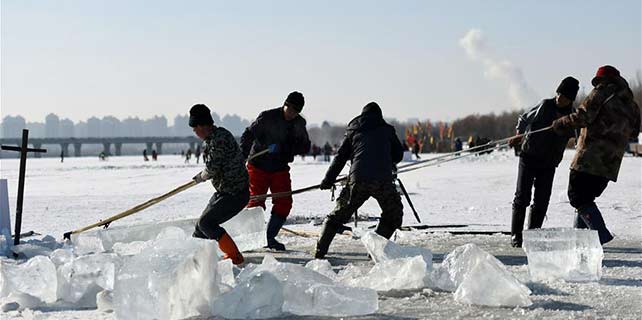E-commerce key to modernized farming
To deliver the four elements of internet plus agriculture, there is room for the government and the private sector to work together
The 19th National Congress of the Communist Party of China, held in October, called for implementing the national strategy of revitalizing rural villages and townships. So-called "internet plus agriculture" was identified as an important tool for modernizing agriculture and supporting the strategy of revitalizing villages.
Agriculture employs more than 27 percent of the country's population but contributes less than 9 percent of its gross domestic product. This implies that there is large potential for increasing productivity in the sector.
Internet plus agriculture is a plan to link the entire agricultural value chain from production to marketing through internet-connected networks. It aims to enhance market access through a two-way automated information exchange system between producers and consumers. It provides consumers with product information (including location and quality), while supporting producers with access to market information and production support services.

An effective system for internet plus agriculture will require four key elements: an e-commerce platform, agricultural logistics, farmers' participation and a traceability system for product safety and quality.
First, there has been significant progress establishing an e-commerce platform, but many rural e-commerce stores face steep low-price competition. So far, 3,000 agriculture-related websites exist with different scales of users.
On Taobao, there are 1.63 million stores at village and town levels that are engaged in the online market for agricultural products. This development has greatly contributed to the improvement of quality of life in rural China. However, farmers' profit margins remain low despite the increasing sales volume. In a recent survey conducted by China Agricultural University, many operators said they cannot bear the high promotion fees and complained about the "ranking based on price" mechanism of the large platforms.
Since many specialist producers are competing on quality, this makes it very difficult for them. For these sellers to survive in this competitive market, they will have to join the low-price competition with "sales at a loss" to gain sales volume. For example, eggs from Yicheng, Hubei province, are being sold online at 0.80 yuan per egg, but the selling price in the local market is 0.96 yuan per egg. Without profits, shops cannot invest in new product development, quality improvement and material development. Consequently, it is difficult to advance know-how, which hampers establishment of branding for product differentiation.
Second, China is the world's largest producer and consumer of agricultural products. Its agricultural logistics system is responsible for moving food products from farms to the tables of more than 1 billion consumers.
For perishable agricultural products, a reliable logistics system is essential for internet plus agriculture. A recent study jointly conducted by the State Council's Development Research Center and the Asian Development Bank identified several key challenges in agricultural logistics: scale of operations, packaging standards, product grading and food safety, market information systems and cold chain technology.
Third, building offline service centers in rural areas and attracting farmers to shop online are not easy tasks. There are two issues to be addressed in this aspect. The first issue is how to organize small farmers. It is important to set up rural cooperatives and select a few leaders who will help to organize the farmers. These rural cooperatives and farmer leaders can also help in opening the online stores.
Another issue is the difficulty of attracting young talent who can understand the technology to work for internet plus agriculture in rural areas.
Fourth, precision agriculture or so-called "smart agriculture" is an essential part of transforming rural agriculture in China. It is expected that network-connected sensors - the so-called internet of things - can, for example, monitor soil moisture, air temperature and location of products in the distribution chain.

Feeding information collected from the internet of things into data analysis centers can provide specialized real-time production and management services to farmer cooperatives as well as product safety information to consumers. Benefits will result from increased production, reduced input costs, reduced environmental pollution and marketing risks, and access to premium markets via traceability services for agricultural products.
However, relatively high costs have become the key barrier preventing the scaling-up of smart agriculture technologies. An expert from China Agricultural University found that a soil data monitoring sensor being sold for about 3,000 yuan ($466; 382 euros; £338) in the market can very easily fail after being installed at farms.
The poor quality and high cost of the device can easily cost the farmers and/or owners a maintenance fee as high as 5,000 yuan per mu per year. Since one hectare equals 15 mu, this amounts to 75,000 yuan per hectare.
To deliver the four elements of internet plus agriculture, there is room for the government and the private sector to work together. International financing institutions like the Asian Development Bank can also play an important role.
Since Alibaba and JD.com are focusing on rural e-commerce platforms, the government and the ADB may prioritize their investments in activities associated with public goods.
These could include providing good broadband coverage to villages; building rural roads in underdeveloped areas; establishing public big data platforms involving the rural economy; making the traceability system for agricultural product quality easier for small farmers; building cold chain logistics facilities; and strengthening the rural credit system platform.
The author is director of the environment, natural resources and agriculture division of the East Asia department of the Asian Development Bank. The views do not necessarily reflect those of China Daily.
(China Daily European Weekly 01/19/2018 page9)


















